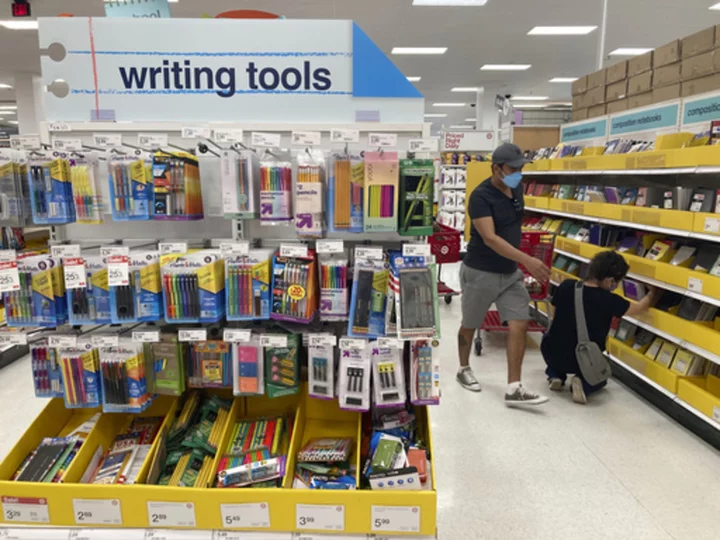When Meghan Lakata’s kids return to school from summer break, they’ll have new (to them) clothes and supplies. But thanks to some creative shopping habits, the mother of two isn’t stressed over back-to-school spending.
Lakata, a pre-K teacher in Maryland, uses tools like state sales tax holidays, cash-back apps and buy-nothing groups to keep back-to-school costs down. Bulk purchases help, too.
“I have the two kids and there’s a lot of overlap in what they need,” Lakata says. “So if I can get like a big 48-count of pencils, I’m going to do that.”
If back-to-school spending forecasts for 2023 are correct, every little bit of savings might help. According to the National Retail Federation, families with children in kindergarten through 12th grade will spend a record $41.5 billion on back-to-school shopping this year. An additional $94 billion will be spent on back-to-college shopping. Those figures make the back-to-school season the second-largest spending period of the year, after holiday shopping.
Here’s how to keep more money in your pocket this season.
1. SALES TAX HOLIDAYS
Search your state tax administrator’s website to see whether your state is one of several with a tax-free holiday. If so, in-person and online shopping for items like clothing, books, school supplies and electronics during the designated time frame could provide a 4%-7% pad to your budget.
“I’m planning on getting the kids a couple of new items they want and school supplies that week,” Lakata said, adding that she’ll save 6% without sales tax.
These holidays generally run in July or August. Lakata says this is the time to buy supplies, not only for the tax exemption, but because items are cheaper.
“That box of crayons that’s 50 cents in August is going to be like $2.50 in December,” she says. “They drop the prices so much for back-to-school, but we feel like we can’t get the same deals if we restock midyear. You’re going to pay a lot more.”
2. STUDENT DISCOUNTS ON ELECTRONICS
Electronics top the planned back-to-school expenditure list in 2023, with an estimated $38 billion to be spent for K-12 and college students, according to the NRF survey.
College students can qualify for “education pricing” from companies like Apple, Microsoft, Samsung and Dell. This could lead to savings of 10%-20% or more on that new laptop, tablet, phone or monitor.
Plan to purchase directly through the manufacturer to get the discount; purchases at big box stores like Best Buy or Walmart generally won’t count.
3. BUY-NOTHING GROUPS
An estimated $25 billion will be spent on back-to-school and back-to-college clothing this season, the NRF says. But that could be an expense to offset with your local buy-nothing group.
Buy-nothing groups offer a way for individuals to rehome and gift goods to one another, with no buying, selling or bartering. You can find your community on the Buy Nothing Project website.
“I try to get as much as I can on the buy-nothing Facebook page,” Lakata says. “I got an entire wardrobe of clothes for my kids. I don’t buy new clothes often for them, just because you can get them for free.”
4. CREDIT CARD BONUSES
Many new credit cards come with a sign-up offer that can earn you hundreds of dollars worth of cash-back or travel rewards. Since you’ll have to spend a certain amount of money in a specific window to earn those rewards, periods of high spending can be the perfect time to get a new card and offset some of your costs.
But aim to pay your statement in full each month. If you carry a balance, the interest can negate any rewards.
5. BUY IN BULK
Whether it’s lunch food or school supplies, buying in bulk can lead to big savings — but have a plan. Overpurchasing can erode the savings you made elsewhere.
Lakata says she looks at the school supply list and identifies things both her kids, in 4th and 5th grades, will use; then she buys those items in bulk at a discount.
“Composition notebooks can often be cheaper in a multipack, and last year both kids needed them,” she said. “Or plastic folders. I can get a six-pack of those instead of buying them individually and save money.”
6. CASH-BACK APPS AND WEBSITES
Whether you shop in store or online, a few extra steps – or clicks – can get you a percentage back on your purchases.
Apps like Receipt Hog and Ibotta provide cash back for in-store purchases if you scan your receipt. Once the purchase is verified, cash back or rewards redeemable for gift cards will be deposited into your account.
“After any shopping trip, I take a quick picture of my receipt using cash-back apps,” Lakata said. “Those little points add up.”
If you prefer shopping online, visit a cash-back portal like Top Cashback or Rakuten before you pay. Such portals offer percentages back at a multitude of websites, as long as you click through from the portal first. Your bank or credit card may also offer bonus rewards for shopping through their websites.
_________________________________________
This column was provided to The Associated Press by the personal finance website NerdWallet. Craig Joseph is a writer at NerdWallet. Email: cjoseph@nerdwallet.com.
RELATED LINKS
National Retail Federation: Retail holiday and seasonal trends - Back-to-school https://nrf.com/insights/holiday-and-seasonal-trends/back-to-school
NerdWallet: Is a credit card sign-up bonus worth it? Here’s how to tell https://bit.ly/nerdwallet-is-a-credit-card-bonus-worth-it
METHODOLOGY
Since 2003, NRF has conducted a comprehensive survey on back-to-class shopping trends. This year’s annual survey was released by the National Retail Federation and Prosper Insights & Analytics. This year’s research included 7,843 consumers and was fielded June 30-July 6 with a margin of error of plus or minus 1.1 percentage points.
National Retail Federation. (July, 2023). “Back-to-Class Shopping Expected to Reach Record Levels.” https://nrf.com/media-center/press-releases/back-class-shopping-expected-reach-record-levels

